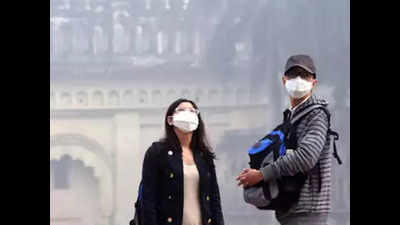- News
- City News
- lucknow News
- Lucknow coughs through most polluted day of season
Trending
This story is from November 2, 2019
Lucknow coughs through most polluted day of season
With Air Quality Index (AQI) of Lucknow touching 382 (severe) on Friday, the city not only witnessed its most polluted day post-monsoon so far, but also saw the worst air quality on November 1 in three years.

According to data from the Central Pollution Control Board (CPCB), Lucknow’s AQI was in the hazardous category, exposure to which can lead to serious respiratory issues.
LUCKNOW: With Air Quality Index (AQI) of Lucknow touching 382 (severe) on Friday, the city not only witnessed its most polluted day post-monsoon so far, but also saw the worst air quality on November 1 in three years.
Track the pollution level in your city
According to data from the Central Pollution Control Board (CPCB), Lucknow’s AQI was in the hazardous category, exposure to which can lead to serious respiratory issues.
According to live monitoring by CPCB on Friday evening, PM2.5 concentration in Lucknow peaked to 450 microgram per cubic metre of air in Lalbagh, making it the most polluted locality of the city. It was followed by Talkatora, Aliganj and Nishatganj with PM2.5 concentration recorded 403, 289 and 280 respectively.
Lucknow University air quality monitoring station director Prof Dhruvsen Singh said, “It was not just PM2.5 concentration but even gaseous pollutants peaked in the city with carbon dioxide and ozone levels recorded 428.64 and 46.6 respectively.
After Diwali on October 27, pollution level in the city has increased by around 150 units.
Track the pollution level in your city
According to data from the Central Pollution Control Board (CPCB), Lucknow’s AQI was in the hazardous category, exposure to which can lead to serious respiratory issues.
TimesView
District administration has directed various civic agencies to take measures to check air pollution, but barring few measures, no significant effort is visible on the streets. Though sprinkling of water was done at few places and green nets were put up at some construction sites to check dust particles from polluting the atmosphere, a quick TOI survey found that there still many under construction sites and broken roads where preventive measures have not been taken. Open garbage burning is also going on unchecked. Civic agencies need to realise that air pollution level of the city is already in `very poor' category, hence they need to act fast to check it from becoming `hazardous'.
In 2017 and 2018, AQI on November 1 was 301 and 302 respectively.
According to live monitoring by CPCB on Friday evening, PM2.5 concentration in Lucknow peaked to 450 microgram per cubic metre of air in Lalbagh, making it the most polluted locality of the city. It was followed by Talkatora, Aliganj and Nishatganj with PM2.5 concentration recorded 403, 289 and 280 respectively.
Lucknow University air quality monitoring station director Prof Dhruvsen Singh said, “It was not just PM2.5 concentration but even gaseous pollutants peaked in the city with carbon dioxide and ozone levels recorded 428.64 and 46.6 respectively.
After Diwali on October 27, pollution level in the city has increased by around 150 units.
End of Article
FOLLOW US ON SOCIAL MEDIA










